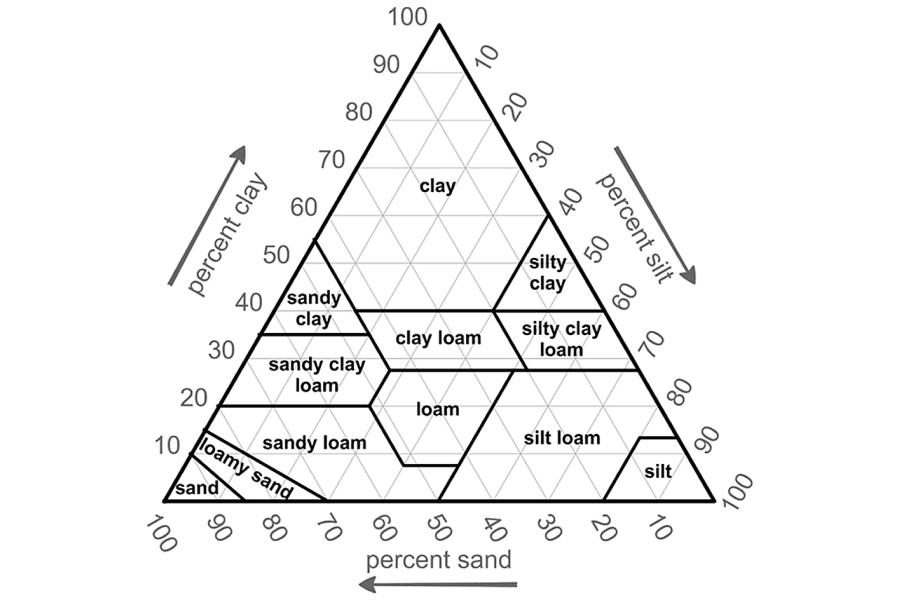Understanding Soil Textures and their Water Holding Capacities

Winegrowing is a dirty business. Like almost any form of farming, soil is a key factor in determining everything from what grape variety grows where to what its fruit tastes like. There’s a whole lot of soil-based chemistry and biology involved in the growing process, influenced by things like organic composition and pH. But the factor we’re most interested in is water (surprise!).
In this post we’ll examine four primary soil textures - sand, clay, silt, and loam - and their water holding capacities, or the equal inverse: drainage. It’s jargon we hear often in wine environments.
“Fast draining soils really let the vines struggle!”
“Slow draining soils retain water, so these vines don’t need much irrigation!”
Measuring Soil Moisture
Before we dive into soil types and their water holding capacities, let’s briefly review best practices for monitoring soil moisture during the growing season. For accurate data, it’s important that we take measurements at multiple soil depths. One of the best technologies available are soil moisture probes, which typically use capacitance sensors at multiple depths from 0 to 48 inches, although some probes may be longer. Each sensor measures the conductivity of the soil at its depth, which is determined primarily by its water content. That electrical measurement is converted to show the percent of moisture in a soil.
Viticulturists and grape growers can use this data over the course of a growing season to determine how much they need to irrigate their vines in order to achieve their desired outcome.
Primary Soil Textures and their Water Holding Capacities
Sandy soils are composed of tiny bits of pulverized and weathered rocks. With little ability to retain water, sand drains well, making this soil type best for growing grapes in wet climates. Because sand holds little water and contains little to no organic matter, it helps prevent disease and pests, like phylloxera, from flourishing. Essentially, it’s less fertile and dry, which can be great for gently stressing vines while protecting them from threats in appropriate regions. But in dry climates, sand on its own can be extremely difficult to work with because it doesn’t retain enough water for the plant.
In warm climates, sandy soils tend to produce wines with less color, lower levels of acidity, and less tannin. In cool climates, they tend to produce more aromatic wines.
Clay soils, of which there are many different types, tend to retain water due to an intricate lattice network that makes drainage difficult. Deep clay soils tend to be mineral-rich and stay cool, which is ideal for warm climates. Clay often contains limestone, such as Calcareous Clay, which may remain even cooler. These soils can be problematic in wet regions, forcing moisture to accumulate, creating a breeding ground for disease and pests and suffocating the vine’s roots.
Clay soils tend to produce concentrated, bold wines with deep color.
Silt soils, including Loess (wind-blown silt with high quantities of silica), are light soils that retain water well. Silt is more finely textured than sand and can become overly compacted and waterlogged, preventing root growth while creating a ripe environment for disease. Some silt soils are actually too fertile for quality grape growing, but when properly balanced with other soils, silt soils can lend a helping hand to vine growth.
Silt soils tend to produce smooth, round wines with lower levels of acidity.
Loam soils are typically formed by a somewhat-equal mix of silt, clay, and sand, as well as humus (decomposed organic matter). Often very fertile, loam has varying water holding potential depending on its composition. Because of its fertility, loam typically can lead to overly vigorous vines, resulting in fruit that’s less concentrated in flavor and color. But certain mixtures, like sandy loam, can keep the soil poor enough to produce great quality fruit.
Texture is not the only factor that determines water holding capacity. Rocks, like gravel, slate, and schist also affect drainage and soil temperature. There’s no recipe for perfect soil for winegrowing. Numerous soil types in different climates, combined with different varieties, clones, and rootstocks create vast possibilities for wine production. That’s the beauty of dirt.
Conclusion
Soil types aren’t universal across regions, nor are they unique to a specific vineyard. They often vary from one side of a field to another, and they’re often even layered upon each other. Endless combinations of soil types yield fruit that varies widely, even across the same clone of one variety. This makes blending a key tool in the winemaker’s arsenal, but it also makes precision irrigation infrastructure extremely important for growers looking to customize their irrigation schedules to the unique needs of each block’s soil profile. Without this, growers risk losing all the amazing potential their varied soils offer them.
To learn more about precision irrigation solutions, contact us here or email [email protected]